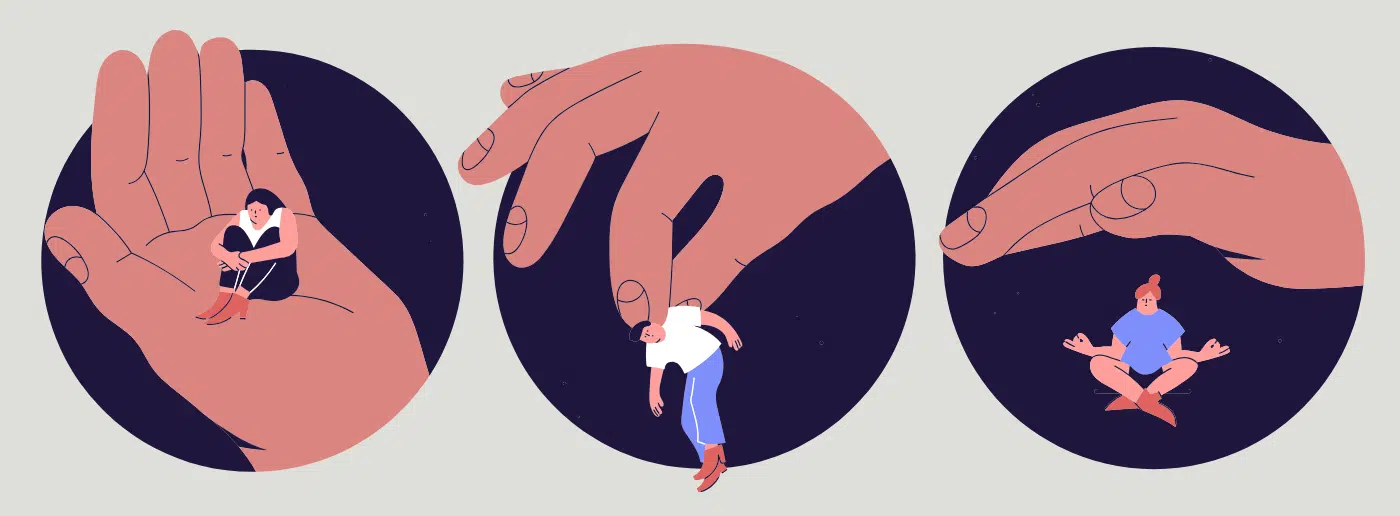Attention Deficit Hyperactivity Disorder (ADHD) is a neurodevelopmental condition that affects approximately 5% to 7.2% of children and 2.5% to 6.7% of adults worldwide. In the United States, recent data suggests an even higher prevalence among children, with an estimated 8.7% or about 5.3 million affected.
If you’ve been wondering what types of ADHD are out there, or if you’ve been trying to better understand yours, you’ve come to the right place.
ADHD vs ADD: What's the Difference?
The term ADD, or Attention Deficit Disorder, was commonly used before the 1990s. It referred to individuals who had trouble focusing, whether they were hyperactive or not. If you were more of the quiet type, someone whose mind wandered most of the time and struggled to concentrate, you would fall under ADD.
Experts once believed that attention problems and hyperactivity were separate issues. However, as research progressed, it became clear that these symptoms are interconnected and fall under the umbrella of ADHD (Attention Deficit Hyperactivity Disorder). This understanding highlights that similar treatment approaches are needed whether someone is overly active or simply inattentive.
In the early ’90s, a significant shift occurred when the term ADD was replaced with ADHD to encompass all attention-related challenges. This change aimed to provide clarity in diagnosis, but many still use ADD to refer to the inattentive type of ADHD specifically.
Do I Have ADHD?
If you’re wondering, “Do I have ADHD?” or “Does my child have ADHD?” the symptoms can vary by age and gender. ADHD in adults might look different than in kids, with more subtle symptoms like restlessness or difficulty completing tasks. Similarly, ADHD symptoms in girls can be less noticeable because girls are less likely to display hyperactivity.
Some common signs of ADHD in children include:
- Difficulty staying focused or attentive
- Trouble following instructions
- Consistently being unable to complete classwork in time
- Easily distracted by outside stimuli
- Making careless mistakes
- Difficulty keeping track of papers, losing books and other materials often
- Restlessness, constant movement, or fidgeting
- Impulsivity, such as blurting out answers or interupting others
- Social challenges – easily frustrated, doesn’t work well with others, or acts withdrawn

For adults, frequent traits include:
- Struggling with time management
- Being easily distracted
- Forgetfulness
- Difficulty concentrating and staying focused
- Difficulty completing tasks or projects
- Difficulty shifting your attention to a new task
- Difficulty managing your frustration and emotions
- Difficulty organizing, prioritizing, and getting started
- Difficulty holding and using multiple pieces of information at once
- Difficulty remembering things you’ve read or learned
Understanding Your ADHD Type
ADHD is a spectrum, with individuals displaying varying degrees of inattentiveness, hyperactivity, or a mix of both.
While many online ADHD tests are available, often for free, they should be approached with caution. These assessments rely heavily on personal self-reports, which can be influenced by an individual’s perception of their behavior. Moreover, ADHD frequently co-occurs with other conditions, such as depression, anxiety, or learning disabilities, which online tests may not adequately address.
A definitive ADHD diagnosis requires a comprehensive evaluation that considers medical history, behavior across different settings, and feedback from family members, teachers, and co-workers. Online tests cannot provide this holistic perspective.
It’s important to note that inattentive symptoms are as significant as hyperactive ones. If you find it hard to focus, often forget things, or feel disengaged during conversations, you might be experiencing predominantly inattentive ADHD.
Here’s how ADHD is categorized:
Inattentive Type
The inattentive type refers to a classification of ADHD characterized primarily by persistent patterns of inattention and distractibility. You are likely to feel scattered, forgetful, and distracted.
This type often displays behaviors such as:
- Zoning out a lot
- Losing track of time or things
- Have trouble finishing tasks
- Lacking attention to detail and getting distracted easily
- Struggling to concentrate on the current task
- Losing interest rapidly
- Having a hard time learning or structuring new information
- Finding it challenging to finish homework
- Getting confused easily
- Appearing not to pay attention when being addressed
- Having trouble adhering to instructions
- Taking longer to process information and making more errors than peers
Hyperactive-Impulsive Type
Ever been told you’re always on the move or that you speak before you think? The Hyperactive-Impulsive Type of ADHD is marked by excessive movement and impulsive actions.
This type often exhibits behaviors like:
- Engaging in fidgeting or restlessness (inability to remain seated)
- Excessive verbal communication
- Difficulty concentrating on quiet tasks such as reading
- Moving rapidly from one location to another; exhibiting behavior as if being driven by a motor
- Repeatedly leaving seat, jumping, or climbing on furniture and other inappropriate surfaces
- Demonstrating impatience
- Inadvertently blurting out comments or answers at inappropriate times
- Interrupting others during conversations
- Experiencing difficulty waiting for their turn or standing in line
- Failing to recognize potentially hazardous situations
- Frequently encountering disciplinary issues
- Acting impulsively without adequate planning
Combined Type
Combined Type ADHD is usually diagnosed when an individual exhibits a significant number of symptoms from both the inattentive and hyperactive-impulsive categories. This dual-symptom requirement provides a holistic assessment that helps in understanding how different symptoms can affect a person’s daily functioning. It also aids in differentiating Combined Type ADHD from other disorders, leading to more accurate diagnoses and tailored treatment plans.
The presence of multiple symptoms often indicates greater severity, guiding the urgency and type of intervention needed. Evaluating symptoms across both categories allows for the identification of possible co-occurring disorders, which can influence treatment strategies.
Requiring a specific number of symptoms ensures consistency in diagnosis across practitioners, facilitating better treatment protocols. Having the aforementioned symptoms from both the inattentive and hyperactive-impulsive categories is essential for accurately diagnosing Combined Type ADHD and providing effective support for individuals facing these challenges.
Will a Professional ADHD Evaluation
Help Me Understand My ADHD Type?
According to a recent study published in the Journal of Attention Disorders, adults diagnosed with ADHD show improved functioning, enhanced health-related quality of life (HRQoL), and higher self-esteem compared to adults who exhibit ADHD or ADD symptoms but remain undiagnosed.
Here’s why getting tested is crucial:
- It’s Personal: ADHD isn’t one-size-fits-all. Someone with inattentive symptoms will need different tools than someone who can’t sit still.
- Relief: Knowing what’s going on can help you better understand your condition, acknowledge your attentional strengths and weaknesses, and start using tools that work for you.
- Avoid Misdiagnosis: ADHD can look a lot like anxiety, depression, or even burnout. Getting the right diagnosis means getting the right help—and not wasting time on treatments that don’t work.
- Support is Waiting: Once diagnosed as a student or employee, you will likely be provided accommodations and support. Children with ADHD in school are provided with tailored strategies, including Individualized Education Plans (IEPs). IEPs are designed to meet each student’s unique needs. They include classroom modifications, behavioral management plans, and multi-sensory instruction.
Diagnosing ADHD: What You Need to Know
ADHD diagnosis involves multiple steps. A neuropsychologist may conduct a neuropsychological evaluation like MOXO to assess cognitive functioning. This includes memory, attention, and problem-solving skills. A cognitive test may be used as part of the diagnostic process, helping to differentiate between ADHD and other cognitive issues.

A formal diagnosis from a professional is essential. Healthcare providers follow the guidelines outlined in the American Psychiatric Association’s Diagnostic and Statistical Manual of Mental Disorders, Fifth Edition (DSM-5), to diagnose ADHD. This standardized approach ensures accurate diagnosis and treatment of ADHD. A positive DSM-5 ADHD diagnosis typically requires six or more symptoms of inattention or hyperactivity-impulsivity, lasting for at least six months.
Stop Guessing—Start Thriving
It might be time to seek answers if you relate to any of the experiences and symptoms mentioned in this article. Getting an evaluation for ADHD goes beyond merely labeling what you’ve been feeling; it’s about understanding your condition and seeking the support and resources that can help improve your daily life. Understanding the features of ADHD—such as difficulties with attention, organization, and impulsivity—can empower you to find strategies that work for you. Remember ADHD can be a superpower and not a weakness; understanding your type of ADHD is a positive step towards making life with ADHD easier and more manageable.
For more content on ADHD, attention profiling, new research, and more, click here to return to the MOXO blog homepage.


